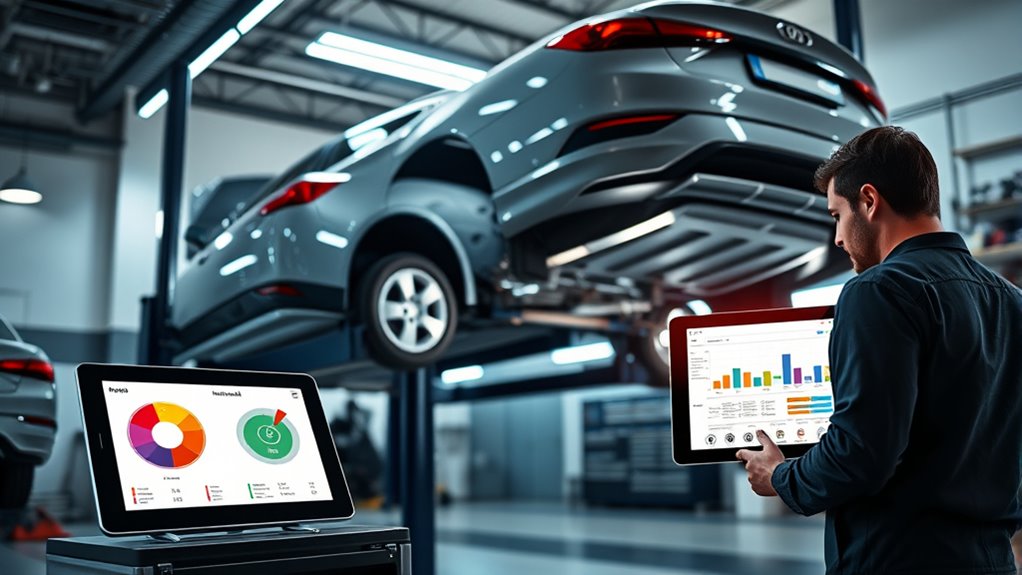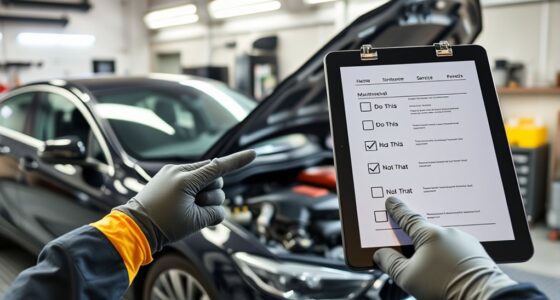You might rely on manual schedules for maintenance, but this can lead to unnecessary expenses and unexpected breakdowns. To get the most out of your equipment, customize your service plans based on usage patterns, environment, and actual wear. Regular inspections help catch issues early, preventing costly repairs. By understanding these key rules and adjusting accordingly, you can save money and boost reliability—if you keep exploring, you’ll learn how to optimize every service interval perfectly.
Key Takeaways
- Base maintenance intervals on real-time data and equipment wear, not just fixed schedules.
- Customize service plans considering usage patterns, environment, and manufacturer recommendations.
- Regular inspections and predictive analytics help identify issues early, preventing costly breakdowns.
- Adjust maintenance frequency for harsh conditions, heavy use, or specific warranty requirements.
- Moving away from manual schedules enables smarter, cost-effective, and personalized maintenance strategies.
The Hidden Cost of Relying on Manual Recommendations

Relying solely on manual recommendations for maintenance intervals can quietly inflate your costs. When you ignore data-driven insights, you’re missing out on the benefits of predictive maintenance, which uses real-time information to schedule service precisely when needed. This approach helps you avoid unnecessary parts replacement and reduces downtime, directly supporting cost optimization. Manual schedules often rely on generic timelines that don’t account for actual equipment wear or operational conditions. As a result, you might perform maintenance too early or too late, wasting resources or risking failure. Embracing predictive maintenance allows you to fine-tune your service plans, saving money and extending equipment life. Additionally, accurate scheduling can help prevent costly breakdowns and ensure equipment operates at peak efficiency. Ultimately, moving away from manual recommendations helps you make smarter, more efficient decisions, safeguarding your bottom line.
When to Customize Your Maintenance Schedule for Better Results

Knowing the right time to customize your maintenance schedule can considerably enhance efficiency and reduce costs. If you notice signs like increased parts inspection needs or frequent repairs, it’s time to adjust your plan. Personalization ensures you’re addressing issues early and avoiding unnecessary expenses. Additionally, consider your warranty coverage—some warranties require specific maintenance intervals, so tailoring your schedule prevents voiding coverage. If your vehicle experiences harsh conditions or heavy usage, more frequent inspections might be necessary. Conversely, if it’s used lightly, extending intervals could save money without risking damage. Regularly reviewing your vehicle’s performance and consulting your manufacturer’s recommendations helps determine when a personalized schedule benefits you most. Crochet styles for locs can inspire creative ways to keep your hair protected and well-maintained. Customizing at the right moments keeps your vehicle reliable and your costs controlled.
The Role of Usage Patterns in Setting Service Intervals

Your vehicle’s usage patterns play a crucial role in determining the appropriate service intervals. If you drive frequently or cover long distances, your usage frequency demands more regular maintenance to keep your vehicle running smoothly. Conversely, if you use your car for short trips or infrequent drives, the wear and tear may be less severe, allowing for longer intervals between services. The operating environment also influences these decisions; city driving with stop-and-go traffic can accelerate component wear, while highway driving tends to be gentler. Understanding how often and under what conditions you use your vehicle helps you tailor maintenance plans more accurately. For example, signs of spoilage such as dirt or debris accumulating in your vehicle can also impact maintenance needs. By aligning service intervals with your specific usage patterns, you ensure peak performance, safety, and longevity of your vehicle.
Understanding the Impact of Environment and Operating Conditions

The environment in which your vehicle operates considerably influences how often you need to perform maintenance. Environmental factors like dust, humidity, temperature extremes, and road salt can accelerate wear and corrosion, requiring more frequent checks and replacements. Operating conditions, such as frequent stop-and-go traffic, heavy loads, or off-road driving, also impact maintenance needs. For example, high temperatures can strain cooling systems, while dusty conditions clog filters faster. Recognizing how these environmental factors and operating conditions affect your vehicle helps you tailor maintenance schedules more accurately. Proper home maintenance can prevent issues caused by environmental stressors, ensuring your vehicle remains reliable and safe in all conditions. Ignoring these influences might lead to overlooked issues or premature part failures. By understanding the environment you drive in, you can plan service intervals more effectively, ensuring your vehicle remains reliable and safe in all conditions.
How Regular Inspections Can Prevent Costly Breakdowns

Regular inspections are essential for catching issues early before they escalate into expensive repairs. By routinely checking your equipment, you can identify wear and tear, preventing breakdowns. Predictive analytics plays a key role here, analyzing data trends to forecast potential failures. This proactive approach reduces unexpected downtime and minimizes warranty claims. To illustrate, consider the following:
| Inspection Type | Benefits |
|---|---|
| Visual Inspection | Detects obvious damage early |
| Data Monitoring | Uses sensors for real-time insights |
| Predictive Analytics | Anticipates failures before they occur |
| Mechanical Checks | Ensures all parts function properly |
Staying ahead with regular inspections saves money and extends your equipment’s lifespan. Spiritual practices such as meditation and mindfulness can also enhance your focus and overall well-being, reinforcing the importance of consistent maintenance routines.
Frequently Asked Questions
How Do Manufacturer Recommendations Differ Across Vehicle Brands?
Manufacturer recommendations differ across vehicle brands due to manufacturer variations and brand specific schedules. You’ll notice that some brands suggest more frequent oil changes, while others extend intervals based on advanced technology or different materials. It’s crucial to follow your vehicle’s specific schedule, as ignoring brand specific schedules can lead to premature wear or damage. Always consult your owner’s manual or dealer to guarantee you’re adhering to the manufacturer’s guidelines for ideal vehicle performance.
Can Maintenance Schedules Be Adjusted for Electric or Hybrid Vehicles?
Yes, you can adjust maintenance schedules for electric and hybrid vehicles. Focus on battery longevity and your charging habits, as they influence maintenance needs. Regularly monitor battery health, avoid frequent fast charging, and follow manufacturer guidelines. By doing so, you optimize performance and extend your vehicle’s lifespan, ensuring you get the most value from your investment. Properly tailored schedules keep your electric or hybrid vehicle running smoothly and efficiently.
What Are Signs Indicating When a Service Interval Should Be Shortened?
You should shorten your service interval if you notice an oil change is needed sooner than planned or if your brakes require frequent inspections. Keep an eye out for warning signs like unusual brake noise, reduced braking performance, or oil leaks. Addressing these issues early ensures your vehicle stays in top shape, preventing costly repairs later. Regularly inspecting your brake system and changing the oil on time helps maintain ideal performance.
How Do Seasonal Changes Influence Maintenance Timing?
Sure, because your car loves to party in extreme weather, seasonal changes definitely influence maintenance timing. When winter’s cold or summer’s heat hits, seasonal wear and climate effects accelerate parts’ deterioration. You should check your vehicle more often during these times, like oil changes, tire rotations, and fluid top-offs. Ignoring this can turn your smooth ride into a bumpy, expensive adventure—so stay proactive, or your car might just throw a tantrum!
Are There Advanced Tools to Personalize Maintenance Plans for Individual Use?
Yes, advanced diagnostic tools and customization options now allow you to personalize maintenance plans. These tools analyze your vehicle’s specific condition, driving habits, and environmental factors to create tailored schedules. By using apps or onboard systems, you can receive real-time insights and adjust maintenance intervals accordingly. This personalized approach helps optimize vehicle performance, prevent unexpected issues, and extend your car’s lifespan, ensuring you stay ahead of maintenance needs.
Conclusion
By following these rules, you’ll keep your equipment running smoothly, like a well-oiled machine. Customizing your maintenance schedule based on how you use and where you operate your equipment can save you money and headaches down the line. Regular inspections act as your first line of defense, preventing costly breakdowns. Remember, staying proactive is like tending a garden—you reap the rewards when you nurture it consistently. Stay vigilant, and your gear will thank you.









